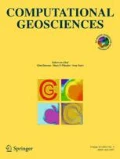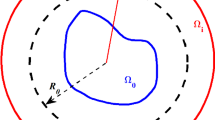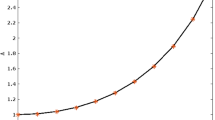Abstract
We present a numerical method for solving a class of systems of partial differential equations (PDEs) that arises in modeling environmental processes undergoing advection and biogeochemical reactions. The salient feature of these PDEs is that all partial derivatives appear in linear expressions. As a result, the system can be viewed as a set of ordinary differential equations (ODEs), albeit each one along a different characteristic. The method then consists of alternating between equations and integrating each one step-wise along its own characteristic, thus creating a customized grid on which solutions are computed. Since the solutions of such PDEs are generally smoother along their characteristics, the method offers the potential of using larger time steps while maintaining accuracy and reducing numerical dispersion. The advantages in efficiency and accuracy of the proposed method are demonstrated in two illustrative examples that simulate depth-resolved reactive transport and soil carbon cycling.
Similar content being viewed by others
References
Ahrens, B., Braakhekke, M.C., Guggenberger, G., Schrumpf, M., Reichstein, M.: Contribution of sorption, DOC transport and microbial interactions to the 14C age of a soil organic carbon profile: insights from a calibrated process model. Soil Biol. & Biochem. 88, 390–402 (2015)
Allison, S.D., Wallenstein, M.D., Bradford, M.A.: Soil-carbon response to warming dependent on microbial physiology. Nature Geosci 3, 336–340 (2010)
Arbogast, T., Wheeler, M.F.: A characteristics-mixed finite element method for advection-dominated transport problems. SIAM J. Numer. Anal. 32, 404–424 (1995)
Arnold, D.N.: Stability, consistency, and convergence of numerical discretizations. Encyclopedia of App. and Comput. Mathematics, pp. 1358–1364. Springer, Berlin (2015)
Centler, F., Shao, H., Park, C.-H, de Biase, C., Kolditz, O., Thullner, M.: GeoSysBRNS—a flexible multi-dimensional reactive transport model for simulating biogeochemical subsurface processes. Comput. Geosci. 36, 397–405 (2010)
Chiang, C.Y., Wheeler, M.F., Bedient, P.B.: A modified method of characteristics technique and mixed finite elements method for simulation of groundwater solute transport. Water Resour. Res. 25, 1541–1549 (1989)
Douglas J., Jr: Simulation of miscible displacement in porous media by a modified method of characteristic procedure. In: Numerical analysis. Springer, Berlin, pp. 64–70 (1982)
Douglas J., Jr, Russell, T.F.: Numerical methods for convection-dominated diffusion problems based on combining the method of characteristics with finite element or finite difference procedures. SIAM J. Numer. Anal. 19, 871–885 (1982)
Donea, J., Quartapelle, L.: An introduction to finite element methods for transient advection problems. Comp. Methods App. Mech. Eng. 95, 169–203 (1992)
Downes, B.J., Lancaster, J.: Does dispersal control population densities in advection-dominated systems? A fresh look at critical assumptions and a direct test. Journal of Animal Ecology. 79, 235–248 (2010)
Ewing, R.E.: Simulation of multiphase flows in porous media. Trans. Porous Media 6, 479–499 (1991)
Ewing, R.E., Wang, H.: A summary of numerical methods for time-dependent advection-dominated partial differential equations. J. Comput. Appl. Math. 128, 423–445 (2001)
Ewing, R.E., Russell, T.F., Wheeler, M.F.: Convergence analysis of an approximation of miscible displacement in porous media by mixed finite elements and a modified method of characteristics. Comput. Methods Appl. Mech. Eng. 47, 73–92 (1984)
Fang, Y.L., Yabusaki, S.B., Yeh, G.T.: A general simulator for reaction-based biogeochemical processes. Comput. Geosci. 32, 64–72 (2006)
Frei, S., Knorr, K.H., Peiffer, S., Fleckenstein, J.H.: Surface micro-topography causes hot spots of biogeochemical activity in wetland systems: a virtual modeling experiment. J. of Geophys. Res. 117, 1–18 (2012)
Gruber, J.: Contaminant accumulation during transport through porous media. Water Resour. Res. 26, 99–107 (1990)
Hararuk, O., Smith, M.J., Luo, Y.: Microbial models with data-driven parameters predict stronger soil carbon responses to climate change. Global Change Biol 21, 2439–2453 (2015)
Harten, A., Engquist, B., Osher, S., Chakravarthy, S.R.: Uniformly high order accurate non-oscillatory schemes, III. J. of Comput. Phys. 71, 231–303 (1987)
Ham, F.E., Lien, F.S., Strong, A.B.: A fully conservative second-order finite difference scheme for incompressible flow on nonuniform grids. J. of Comput. Phys. 177, 117–133 (2002)
Holstad, A.: A mathematical and numerical model for reactive fluid flow systems. Comput. Geosci. 4, 103–139 (2000)
Knabner, P.: Finite-element-approximation of solute transport in porous media with general adsorption processes. In: Xiao, S.-T. (ed.) Flow and transport in porous media, pp. 223-292. World Scientific, Singapore (1992)
Knabner, P., Totsche, K.U., Kögel-Knabner, I.: The modeling of reactive solute transport with sorption to mobile and immobile sorbents. 1. Experimental evidence and model development. Water Resour. Res. 32, 1611–1622 (1996)
Knabner, P., Igler, B.A., Totsche, K.U., DuChateau, P.: Unbiased identification of nonlinear sorption characteristics by soil column breakthrough experiments. Comput. Geosci. 9, 203–217 (2005)
Lakoba, T.: Method of characteristics for solving hyperbolic PDEs, University of Vermont. http://www.cems.uvm.edu/∼tlakoba/math337/notes_17.pdf. Accessed 11 April 2016
Lele, S.K.: Compact finite difference schemes with spectral-like resolution. J. of Comput. Phys. 103, 16–42 (1992)
Leveque, R.: Finite volume methods for hyperbolic problems. Cambridge University Press, Cambridge (2002)
Li, J., Wang, G., Allison, S.D., Mayes, M.A., Luo, Y.: Soil carbon sensitivity to temperature and carbon use efficiency compared across microbial-ecosystem models of varying complexity. Biogeochem. 119, 67–84 (2014)
Liu, X.D., Osher, S., Chan, T.: Weighted essentially non-oscillatory schemes. J. of Comput. Phys. 115, 200–212 (1994)
Matzner, E., Zuber, T., Alewell, C., Lischeid, G., Moritz, K.: Trends in deposition and canopy leaching of mineral elements as indicated by bulk deposition and throughfall measurements. In: Matzner, E. (ed.) Biogeochemistry of forested catchments in a changing environment, pp. 233–250. Springer, Berlin (2014)
Mayes, M.A., Heal, K.R., Brandt, C.C., Phillips, J.R., Jardine, P.M.: Relation between soil order and sorption of dissolved organic carbon in temperate subsoils. Soil Sci. Soc. Am. J. 76, 1027–1037 (2011)
Mazzia, A., Putti, M.: High order Godunov mixed methods on tetrahedral meshes for density driven flow simulations in porous media. J. of Comput. Phys. 208, 154–174 (2005)
Meysman, F.J.R., Boudreau, B.P., Middelburg, J.J.: Modeling reactive transport in sediments subject to bioturbation and compaction. Geochimica et Cosmochimica Acta 69, 3601–3617 (2005)
Olver, P.J.: Introduction to partial differential equations, Chapters 2 and 5. Springer, Berlin (2014)
Osher, S., Solomon, F.: Upwind difference schemes for hyperbolic systems of conservation laws. Mathematics of Comput 38, 339–374 (1982)
Russel, T.F., Wheeler, M.F.: Finite element and finite difference methods for continuous flow in porous media. In: Ewing, R.E. (ed.) The mathematics of reservoir simulation, pp. 35–106. SIAM, Philadelphia (1984)
Riley, W.J., Maggi, F., Kleber, M., Torn, M.S., Tang, J.Y., Dwivedi, D., Guerry, N.: Long residence times of rapidly decomposable soil organic matter: application of a multi-phase, multi-component, and vertically resolved model (BAMS1) to soil carbon dynamics. Geosci. Model Dev 7, 1335–1355 (2014)
Rinaldo, A., Beven, K.J., Bertuzzo, E., Nicotina, L., Davies, J., Fiori, A., Russo, D., Botter, G.: Catchment travel time distributions and water flow through in soils. Water Resour. Res. 47, 1–13 (2011)
Scovazzi, G., Wheeler, M.F., Mikelić, A., Lee, S.: Analytical and variational numerical methods for unstable miscible displacement flows in porous media. J. of Comput. Phys. 335, 444–496 (2017)
Shu, C.W., Osher, S.: Efficient implementation of essentially non-oscillatory shock-capturing schemes. J. of Comput. Phys. 77, 439–471 (1988)
Sinsabaugh, R.L., Mazoni, S., Moorhead, D.L., Richter, A.: Carbon use ef?ciency of microbial communities: stoichiometry, methodology and modelling. Ecology Lett. 16, 930–939 (2013)
Steefel, C.I., DePaolo, D., Lichtner, P.C.: Reactive transport modeling: an essential tool and a new research approach for the Earth sciences. Earth Planet Sci. Lett. 240, 539–558 (2005)
Steefel, C.I., Appelo, C.A.J., Arora, B., et al.: Reactive transport codes for subsurface environmental simulation. Comput. Geosci. 19, 445–478 (2015)
Strikwerda, J.C.: Finite difference schemes and partial differential equations. Wadsworth and Brooks/Cole, Pacific Grove (1989)
Tadmor, E.: A review of numerical methods for nonlinear partial differential equations. Bull. Am. Math. Soc. 49, 507–554 (2012)
Tang, J.Y., Riley, W.J., Koven, C.D., Subin, Z.M.: CLM4-BeTR, a generic biogeochemical transport and reaction module for CLM4: model development, evaluation, and application. Geosci. Model Dev 6, 127–140 (2013)
Todd-Brown, K.E.O., et al.: Changes in soil organic carbon storage predicted by Earth system models during the 21st century. Biogeosci 11, 2341–2356 (2014)
Weill, S., Mazzia, A.M., Putti, M., Paniconi, C.: Coupling water flow and solute transport into a physically-based surface–subsurface hydrological model. Adv. in Water Res 34, 128–136 (2011)
Wieder, W.R., Allison, S.D., Davidson, E.A., et al.: Explicitly representing soil microbial processes in Earth system models. Global Biogeochem. Cycles. 29, 1782–1800 (2015)
Wiggert, D.C., Wylie, E.B.: Numerical predictions of two-dimensional transient groundwater flow by the method of characteristics. Water Resour. Res. 12, 971–977 (1976)
Acknowledgments
We thank the two anonymous reviewers for their constructive input, which greatly improved this manuscript. This material is based upon work supported by the U.S. Department of Energy, Office of Science, Office of Biological and Environmental Research, as part of the Terrestrial Ecosystem Science Program under Contract No. DE-AC02-05CH11231.
Funding
K.G. acknowledges support from the National Science Foundation Graduate Research Fellowship under Grant No. DGE 1106400 and the U.S. Department of Energy, Office of Science, Office of Workforce Development for Teachers and Scientists, Office of Science Graduate Student Research (SCGSR) program. The SCGSR program is administered by the Oak Ridge Institute for Science and Education (ORISE) for the DOE. ORISE is managed by ORAU under contract number DE-SC0014664.
Author information
Authors and Affiliations
Corresponding author
Rights and permissions
About this article
Cite this article
Georgiou, K., Harte, J., Mesbah, A. et al. A method of alternating characteristics with application to advection-dominated environmental systems. Comput Geosci 22, 851–865 (2018). https://doi.org/10.1007/s10596-018-9729-5
Received:
Accepted:
Published:
Issue Date:
DOI: https://doi.org/10.1007/s10596-018-9729-5
Keywords
- Soil biogeochemical cycles
- Reactive transport modeling
- Numerical methods
- Partial differential equations
- Method of characteristics




